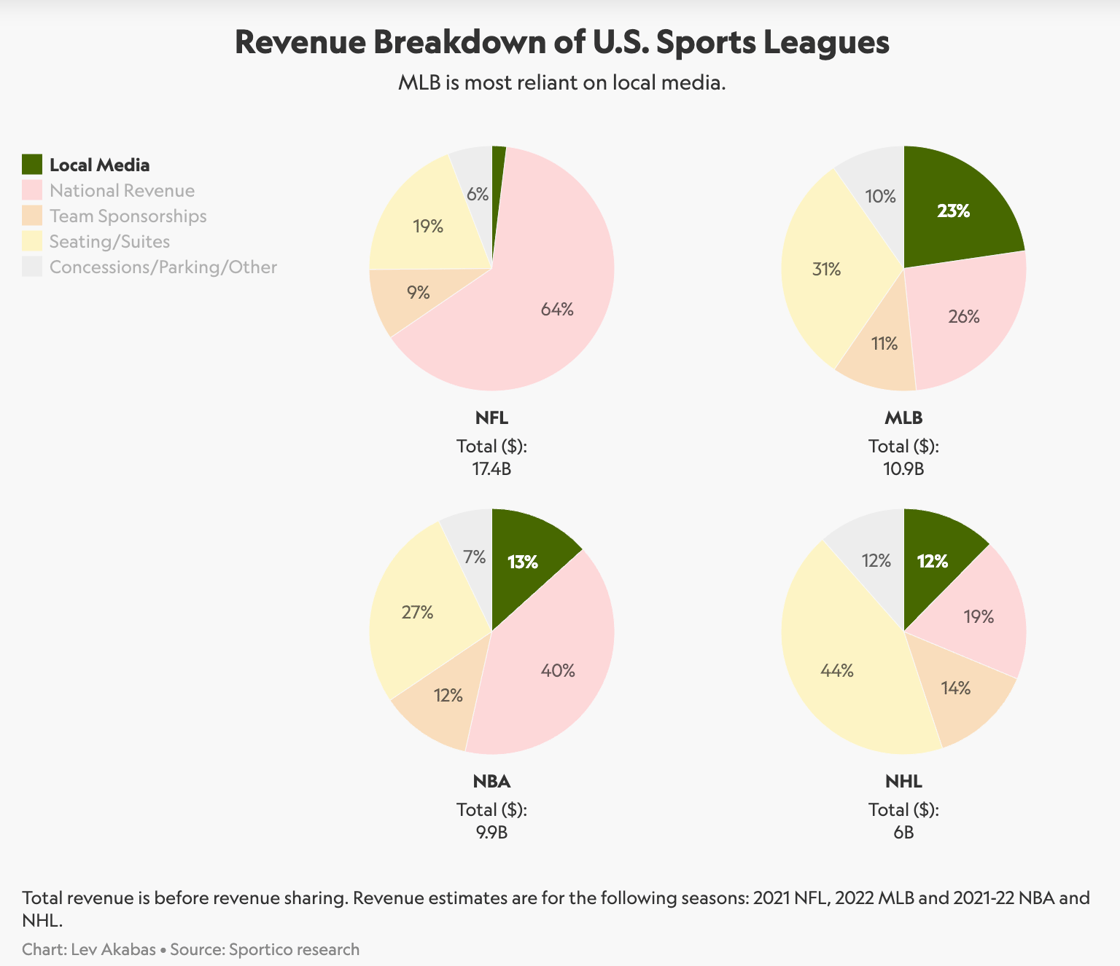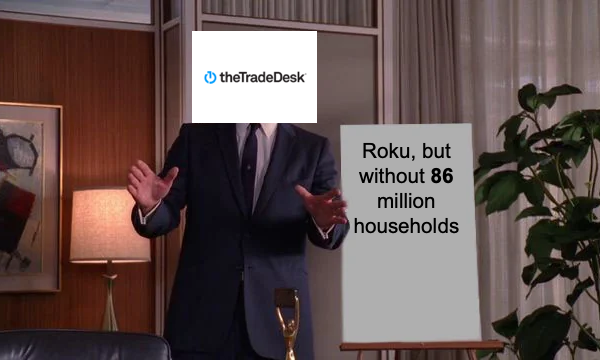
Six big questions re: baseball + local TV:
1) How much does buying a Major League Baseball (MLB) team cost?
2) How does Major League Baseball make money?
3) What share of revenue comes from local TV?
4) How do current issues with regional sports networks (RSN) impact MLB revenue?
5) How many pay-TV subscribers regularly watch an RSN?
6) How long is the average Major League Baseball game?
Setting the table: No league is more susceptible to fluctuations in local TV rights than Major League Baseball (MLB).
Big question #1: How much does buying a Major League Baseball (MLB) team cost?
MLB franchise value (YoY growth) according to Forbes:
1) 2014 – $811M (↑ 9%)
2) 2015 – $1.20B (↑ 48%)
3) 2026 – $1.29B (↑ 7%)
4) 2017 – $1.54B (↑ 19%)
5) 2018 – $1.65B (↑ 7%)
6) 2019 – $1.78B (↑ 8%)
7) 2020 – $1.85B (↑ 4%)
8) 2021 – $1.90B (↑ 3%)
9) 2022 – $2.07B (↑ 9%)
10) 2023 – $2.32B (↑ 12%)
Top five MLB franchises by value (YoY growth):
1) New York Yankees – $7.1B (↑ 18%)
2) Los Angeles Dodgers – $4.8B (↑ 18%)
3) Boston Red Sox – $4.5B (↑ 15%)
4) Chicago Cubs – $4.1B (↑ 8%)
5) San Francisco Giants – $3.7B (↑ 6%)
Flashback #1: Will the MLB Lockout Dampen Advertiser Enthusiasm?
Big question #2: How does Major League Baseball make money?
Source of revenue (% of total) for Major League Baseball according to Sportico:
1) Ticket sales – $3.4B (31%)
2) National revenue – $2.8B (26%)
3) Local media – $2.5B (23%)
4) Team sponsorships – $1.2B (11%)
5) Concessions/Parking/Other – $1.0B (9%)
Big question #3: What share of revenue comes from local TV?
Quick answer: 23%. The highest of any of the four largest U.S. sports leagues.
Share of revenue from local TV according to Sportico:
1) MLB – 23%
2) NBA – 13%
3) NHL – 12%
4) NFL – 1%
Wow: 85%+ of local media revenue comes from regional sports networks (RSN).
Big question #4: How do current issues with regional sports networks (RSN) impact MLB revenue?
Quick answer: Recently, WarnerBros. Discovery (WBD) announced it would exit the RSN business, while Bally Sports filed for bankruptcy. It is unclear how teams will recoup revenue if these deals go away.
Bottom line: Cord cutting is having a big impact on the RSN business. Some deals with local teams no longer make sense.
Quick math on the Pittsburgh Pirates’ local TV deal:
1) WBD pays the Pirates $61M/year
2) 28K HH watch the Pirates on AT&T SportsNet
3) WBD pays $2,179/year for each HH that watches the Pirates
4) Each Pirate watching HH would have to pay $182/month for the team to generate $61M/year without the RSN
2022 team payroll vs. RSN revenue for Pittsburgh Pirates:
1) Team payroll – $61.2M
2) RSN revenue – $61.0M
Wow: The fee from AT&T SportsNet was equal to 99.7% of team payroll in 2022.
Big question #5: How many pay-TV subscribers regularly watch an RSN?
Quick answer: ≈ 10-15% of pay-TV subscribers regularly watch their local RSN.
Quote from Marc Ganis – Sports Consultant:
“Let’s say you have $4 a month (through a pay-TV bundle). If only 20 percent buy (a new standalone option), just to get the same amount of subscription, you’ve got to pay a multiple of five for those who want it. That’s just mathematics.”
Top 5 teams ranked by local TV ratings according to MLB.com:
1) St. Louis Cardinals – 7.9
2) San Diego Padres – 5.2
3) Milwaukee Brewers – 5.1
4) Philadelphia Phillies – 4.5
5) Houston Astros – 4.4
Wow: Local MLB games are the #1 primetime programming in 13 of 29 U.S. markets.
Average household rating in the St. Louis media market:
1) St. Louis Cardinals – 7.9
2) Tucker Carlson – 1.9
Why this matters: A local sports network can be extremely popular yet a terrible business due to overpaying for rights.
Outstanding question: How does the loss of an RSN impact franchise valuations and player payrolls?
Quote from Lee Berke – Sports Media Consultant:
“The one thing is that this is not a crisis in terms of the value of sports content, sports games, teams are being watched and the ratings are strong and much stronger than virtually any other television category. It’s not the ratings that are a problem. It’s the business model that’s a problem and changing the business model that needs to be done in order to help everybody concerned fully realize the value of the sports content that they’re offering up.”
Flashback #2: The RSN Streaming Race Has Begun
Big question #6: How long is the average Major League Baseball game?
Quick answer: Last year, the average game was 3h 10m. This year, MLB is instituting new rules (pitch clock, etc.) with the hope of cutting 20m+ from each game.







